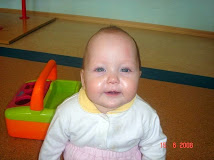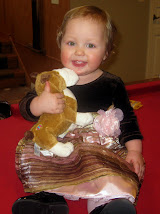
Three of our four boys have large heads. Like 90+ percentile range. I've always said in jest that it is because they have such big brains. Now I don't know if there has been any scientific proof of that (and our son with the normal size head is equally as bright as his big headed brothers), but thankfully there has never been any reason to be overly concerned about it. The only issues we ever had were with those bibs that pull over babies’ heads. They didn’t go over very well (pun intended) so all bibs at our house had to either snap, tie or use Velcro. They have since grown into their large heads somewhat, but we still have to buy shirts with a large opening at the neck and hoodies (you know, sweatshirts with hoods) are a special challenge. Going it on is a breeze, but does anyone else have trouble getting those things off their child? Whew, it’s a lot of work!
Getting back to the point, in the realm of IA, there seems to be a lot of concern and "issues" about children with small heads. According to the International Adoption Clinic at the University of Minnesota, nearly all brain growth occurs in the first two years and virtually ceases by four years of age. Therefore, head circumference is supposed to accurately reflect brain size and growth during gestation and the first years of life. A small head circumference (microcephaly) has been linked in studies by the Mayo Clinic (in the 1960s) to mental retardation or mentally subnormal. In other words, microcephaly can mean that a child’s brain is not developing normally.
Head circumference is only one of many things that our IA doctors will look at when evaluating our referral. They will also be looking at facial features for signs of FAS (Fetal Alcohol Syndrome), and they will want to know about motor skills, and when (or if) she has reached certain milestones. However, since I know that a healthy brain is a key factor in whether or not our daughter becomes a “happy and productive member of society, able to participate fully in life's joys and opportunities” (quote from UMN), I want to make sure I know how to take an ACCURATE measurement.
Here is what I learned:
Getting back to the point, in the realm of IA, there seems to be a lot of concern and "issues" about children with small heads. According to the International Adoption Clinic at the University of Minnesota, nearly all brain growth occurs in the first two years and virtually ceases by four years of age. Therefore, head circumference is supposed to accurately reflect brain size and growth during gestation and the first years of life. A small head circumference (microcephaly) has been linked in studies by the Mayo Clinic (in the 1960s) to mental retardation or mentally subnormal. In other words, microcephaly can mean that a child’s brain is not developing normally.
Head circumference is only one of many things that our IA doctors will look at when evaluating our referral. They will also be looking at facial features for signs of FAS (Fetal Alcohol Syndrome), and they will want to know about motor skills, and when (or if) she has reached certain milestones. However, since I know that a healthy brain is a key factor in whether or not our daughter becomes a “happy and productive member of society, able to participate fully in life's joys and opportunities” (quote from UMN), I want to make sure I know how to take an ACCURATE measurement.
Here is what I learned:
How to Measure Head Circumference
“Occipitofrontal circumference is a measurement of the circumference of the head around the occiput, or posterior aspect, of the skull, to the most anterior portion of the frontal bone.”
“Occipitofrontal circumference is a measurement of the circumference of the head around the occiput, or posterior aspect, of the skull, to the most anterior portion of the frontal bone.”
And people complain about Legalese! Here is what that means in ENGLISH:
The correct procedure for measuring your child's head is to place the measuring device around the largest area of the head, beginning above the eyebrows and ears, and continuing around the back where her head slopes up prominently from her neck. The goal is to measure her head at the spot where it has the largest circumference. The technical term for this measurement is occipital-frontal circumference (OFC) and it is recorded in centimeters. Most pediatrician's offices use a stiff preformed tape-measuring device, but you can also use a non-stretch tape measure.
The correct procedure for measuring your child's head is to place the measuring device around the largest area of the head, beginning above the eyebrows and ears, and continuing around the back where her head slopes up prominently from her neck. The goal is to measure her head at the spot where it has the largest circumference. The technical term for this measurement is occipital-frontal circumference (OFC) and it is recorded in centimeters. Most pediatrician's offices use a stiff preformed tape-measuring device, but you can also use a non-stretch tape measure.
The boys’ pediatrician said she could give us a measuring devise to take with us on Trip One that looks like this:
You can compare this number to the growth chart from the CDC to calculate your child's head circumference percentile. The chart we’ll be using is for girls up to 36 months (click on chart for link to the CDC):

A small head circumference singled out as the only risk factor would not be enough of a reason for us to decline a referral. A child whose head size has been progressively decreasing is more at risk of developmental delays (and the smaller the head the more profound the deficit) than a child born with a small head that has stayed consistent or even slightly increased as she grows. So a small head does not always indicate a serious problem -- as long as it is not losing ground.
According to Dr. Alla Gordina, (of International Adoptions Medical Support Services) many Russian kids do have small heads and do grow out of this problem, unless... THEY CONTINUE TO HAVE SMALL HEADS... which brings us to the whole new set of questions -
1. Why does she have a small head? - there are a lot of possible reasons for that - hereditary microcephaly, pre-natal exposure to drugs and alcohol, deprivation and neglect, malnutrition, chronic infections (tuberculosis), acute infections (meningitis), chronic diseases (kidneys, lungs, etc), inborn errors of metabolism and so on and so forth.
2. Does "normal" head size mean that the kid would not have any problems? Not necessarily, because many kids with alcohol exposure, mental retardation and developmental/attachment problems have absolutely "normal" head circumferences.
3. What is the "predictable" growth pattern in the case of malnutrition? Usually the weight is suffering first, followed by the delay in growth velocity, with the vital organs (gut, liver, kidneys and brain) failing to develop normally pretty late in the process. That's why we would expect to see a malnourished child to be thin, small, with protuberant belly and "dis-proportionally big" head.
4. What is the "predictable" growth pattern in the case of deprivation and neglect? Head circumference would suffer first with or without failure to thrive. When asked if she believes that most of the kids with the small heads would "catch-up" after adoption, Dr. Gordina replied; “If you are adopting 100 kids at once, yes, many of those 100 will do really well. If you are adopting just one - the only time I would be able to say that this particular child would catch up is when I will see it happening.
As you can see, just like life in general, there are NO GUARANTEES in International Adoption. We just plan to do the best we can to make informed decisions and then take that giant Leap of Faith!
As you can see, just like life in general, there are NO GUARANTEES in International Adoption. We just plan to do the best we can to make informed decisions and then take that giant Leap of Faith!
Well, that’s all the technical information I have for this post. But I do have some funny stories about my big-headed boys. Some of it may be Too Much Information, but I’ll tell it anyway…
When my oldest son was born, his head was soooo big… (You’re supposed to be asking your computer screen “How big was it?”) It was so big that I had to have an emergency c-section. Every time I had a contraction, his heart rate dropped to 50. He was in such distress that the doctors thought the cord must be wrapped around his neck. They rushed me to surgery and my doctor pulled him out head first (leaving his body still in my belly like a scene from an Alien movie) and cleared his airways before fully delivering him. Everyone in the delivery room at Baptist Hospital in Nashville, from my OBGYN to the Nurse Anethesis starting taking bets on how much he was going to weigh. Keep in mind, they could only see his head, and I couldn’t see anything over the blue curtain. Martin just sat on a stool by my head looking like he was going to faint. But that’s another story. Anyway, everyone kept saying things like “This is going to be the biggest baby ever delivered in this hospital!” and “OMG, I’ve never seen a baby so huge!”, and “I bet he’s going to be well over 15 lbs.” When the nurse reported that he was, indeed, only 10 lbs, 3 oz, all the personnel in the room were shocked. I, on the other hand, was beginning to think I had delivered a monster.
Fast forward to C-Section number 3. Same hospital, same Doctor, only this time it took her almost an hour to deliver the baby. His head was so big, it was literally stuck! My doctor tugged and pulled, got up on a stepping stool for better leverage and tugged and pulled some more. Then she resorted to using the vacuum. After a few unsuccessful tries to suck his head out of my belly, she finally had to make the incision larger so she could place the suction cup squarely on his head and yank him out of there. That left a nice round purpley-blue bruise on his poor little (I mean BIG) head. Martin jokingly asked my doctor if she had ever done this before? A remark that she still remembered 19 months later when she delivered our fourth son.
Our fourth son’s delivery was relatively uneventful, although he did end up spending a week in the NICU due to reflux and apnea episodes where he stopped breathing. He was the brute of the NICU weighing in at almost 9 lbs compared to 1 and 2 lb preemies around him. My poor guy’s head was too big for those hospital pink/blue stretchy caps they use for newborns, so we had to bring him a stocking hat from home. Once he started walking, he was still pretty bald and was promptly nick-named “Chicken Little” by some of our friends.
All my boys are so smart (not biased at all here, hehe) so I am sticking to my theory that big heads equal big brains. Now if I can just get them to use those big brains to learn the Russian language -- and teach it to me!
The "monster" head at birth and again at age 2

Liam - 18 months (or Chicken Little w/o the glasses)






























2 comments:
This is a very informative post. I enjoyed reading it.
Joy
Awesome post!!! Great, great information. I just printed off the HC chart for boys to take to Russia with me. Didn't know all of those things you listed. I love the stories about your boys! As if having your first child isn't stressful enough, thinking you gave birth to a monster must have added to that! :-)
Post a Comment